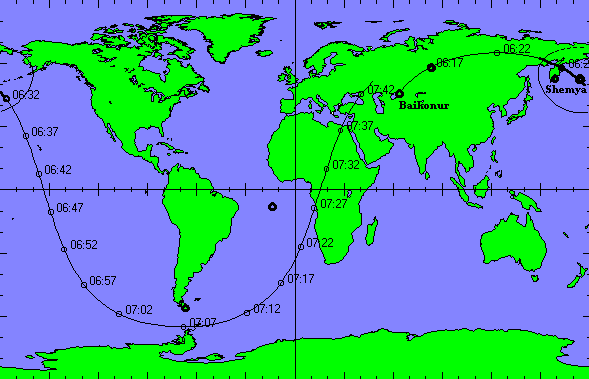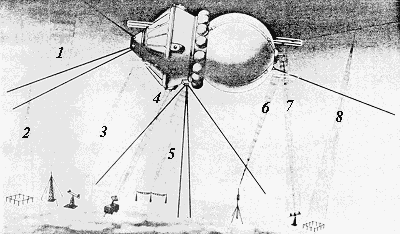TV
from Vostok
Sven Grahn
"Snooping
on Space Pictures"
In an article in the March 1997
issue of Spaceflight (Vol.39, No.3, p.100) Dwayne Day refers to a paper
"Snooping on Space Pictures" by Henry G. Plaster (1).
 Let me quote from H G Plaster's
original text:
Let me quote from H G Plaster's
original text:
" .......Sputniks 5 and 6, launched
respectively on 19 August and 1 December 1960, both transmitted signals on 83
megacycles which were initially reported by field Elint operators and later
confirmed
through detailed analysis to be video transmissions.
Soviet announcements that the dog passengers on these satellites were being
watched while in orbit by means of a 'radio-television' system spurred
on analytical efforts to demodulate this new type of signal, and before
long CIA technical analysts did succeed in producing pictures
from Sputnik 6's
recorded signals. These substantiated the Soviet claim of having developed a
special television transmission system which could provide instantaneous
reporting on the behaviour of animal or human passengers aboard a Soviet
spacecraft.
More important to intelligence
in early 1961, however, was the establishement of a capability to determine
as soon after launch as possible whether the Soviets had successfully orbited
the first man in space, a feat they were expected to attempt at any moment.
The National Security Agency undertook to design and produce special field
collection equipment that would present oscilloscope pictures while the
transmission was being received. Several such sets were produced on a priority
basis, and the first two were sent to Elint sites in Alaska and Hawaii.
Demodulation of video
transmission from Sputnik 9 (9 March 1961) and Sputnik 10 (25 March 1961)
substantiated the Soviet announcement that each of these single-orbit flights
carried a dog passenger. Then on 12 April 1961 Sputnik 11 was launched,
and 83-megacycle transmissions were detected twenty minutes later as the
spacecraft passed over Alaska. Only 58 minutes after launch NSA reported
that real-time readout of signals clearly showed a man and showed him moving.
This before Gagarin had completed his historic 108-minute flight, intelligence
components had technical confirmation that a Soviet cosmonaut was in orbit
and that he was alive." (see picture above right, gracefully provided
by Dwayne Day).
The station
in Alaska
What can we make out of all
this? Let us start with the purported signals in Alaska. What station could
possibly be referred to? Let us assume that the NSA has a station at the
island of Shemya where we know there is a radar installation for tracking
launches of missiles and launch vehicles out of Russia. The table below
show when Vostok would have been over the horizon at Shemya. Vostok was
launched at 0607 UT, so the table shows that Plaster's assertion that TV
signals were detected about 20 minutes after launch agrees well with placing
the NSA ELINT station at Shemya. The phrasing in Plaster's paper seems
to indicate that the picture was not read out successfully, only detected.
SITE: Shemya (Lat:
52.45
Long: 174.05)
| Date |
Time UT |
Latitude
(deg N) |
Longitude
(deg E) |
Altitude
(km) |
Illumination |
Range
(km) |
Azim
(deg) |
Elev
(deg) |
| 1961 Apr 12 |
06:26:00 |
60.28 |
156.51 |
200 |
Sun |
1417 |
315.9 |
1.9 |
| 1961 Apr 12 |
06:27:00 |
57.97 |
162.80 |
203 |
Sun |
977 |
315.1 |
7.8 |
| 1961 Apr 12 |
06:28:00 |
55.35 |
168.25 |
207 |
Sun |
548 |
312.6 |
19.9 |
| 1961 Apr 12 |
06:29:00 |
52.51 |
172.96 |
211 |
Sun |
224 |
275.9 |
69.9 |
| 1961 Apr 12 |
06:30:00 |
49.49 |
177.05 |
214 |
Sun |
451 |
146.2 |
26.6 |
| 1961 Apr 12 |
06:31:00 |
46.33 |
-179.3 |
218 |
Sun |
871 |
142.4 |
10.8 |
| 1961 Apr 12 |
06:32:00 |
43.06 |
-176.2 |
222 |
Sun |
1309 |
141.4 |
4.0 |

A station
in Tierra del Fuego or the Antarctic?
The sentence in Plaster's paper
"Only
58 minutes after launch NSA reported that real-time readout of signals
clearly showed a man and showed him moving", is slightly ambiguous.
Was the report from NSA sent 58 minutes after launch or was the real-time
readout made 58 minutes after launch. Let us assume the latter: Where
was the second station placed? The readout of TV signals was supposed to
have occured 58 minutes after launch. This would be at 0607 + 58 = 0705
UT. Where was Vostok 1 then? Orbital analysis and the map above shows that
Vostok had just come above 5 degrees elevation at Cape Horn at that moment.
Could there have been a station at the southern tip of Tierra del Fuego?
Perhaps! The maximum elevation angle there was only 13 degrees.This is
enough, but a bit low!
There is a U.S.Antarctic
station at a place called Palmer.
From a pure geographical point of view it is ideally placed! The ground
track of an object launched out of Baikonur into a 65o orbit
goes straight over the Palmer base. But, most probably the "58 minutes"
refer to when the report was received. Thus, either Shemya or Hawaii picked
up the signal that showed Gagarin in his capsule.
Can we
find the Vostok TV antennas?
Where on the Vostok were the
TV transmitter antennas located? The sketch below is of Soviet origin and
has been in my files for more than ten years. I do not know where it comes
from, but the translated caption clearly points at the four "fat" antennas
at the back of the service module. Each of these antennas are about a meter
long, which, if a quarter-wavelenth, indicates 4 meters or about 75 MHz
frequency. The antennas are "fat" giving them broadband characteristics.
In this way they could cover the 83 MHz TV frequency and possibly other
frequencies. It is possible that the TV transmitter also carried telemetry,
but I think that there were separate telemetry transmitters, probably in
the 61-76 MHz band. See also the article Radio
systems of Soviet/Russian manned spacecraft.
 |
-
Transmission of operational
telemetry from onboard the spacecraft ("Signal")
-
Reception of terrestrial broadcasting
stations
-
Transmission of telemetry and
televisionimages
from onboard the spacecraft
-
Measurement of the orbit of
the spacecraft
-
Two-way telephony and telegraphy
shortwave communications
-
Command reception
-
Two-way VHF telephony
-
Transmission of operational
telemetry and telegraphy information during the landing phase ("Signal")
|
References
and footnotes
-
Henry
G. Plaster, "Snooping on Space Pictures", Fall 1964 issue of
Studies in Intelligence, found in RG 263, Entry 400, "Articles From Studies
in Intelligence, 1955-1992", National Archives and Records Administration.

 Back
to Space Tracking Notes
Back
to Space Tracking Notes
 Let me quote from H G Plaster's
original text:
Let me quote from H G Plaster's
original text:
 Let me quote from H G Plaster's
original text:
Let me quote from H G Plaster's
original text:
